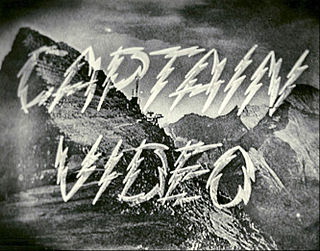
The DuMont Television Network was one of America's pioneer commercial television networks, rivaling NBC and CBS for the distinction of being first overall in the United States. It was owned by Allen B. DuMont Laboratories, a television equipment and television set manufacturer, and began operation on April 13, 1940.
The year 1958 in television involved some significant events. Below is a list of television-related events during 1958.

The Arthur Murray Party is an American television variety show that ran from July 1950 until September 1960. The show was hosted by dancers Arthur and Kathryn Murray, the show featured various acts and celebrity guests and acted as advertisement for their chain of dance studios. Each week, the couple performed a mystery dance, and the viewer who correctly identified the dance would receive two free lessons at a local studio.
Twenty questions is a spoken parlor game which encourages deductive reasoning and creativity. It originated in the United States and was played widely in the 19th century. It escalated in popularity during the late 1940s, when it became the format for a successful weekly radio quiz program.

Captain Video and His Video Rangers is an American science fiction television series that aired on the DuMont Television Network and was the first series of its genre on American television.
The following is the 1954–55 network television schedule for the four major English language commercial broadcast networks in the United States. The schedule covers primetime hours from September 1954 through March 1955. The schedule is followed by a list per network of returning series, new series, and series cancelled after the 1953–54 season.
Dollar a Second is an American comedy game show hosted by Jan Murray which originally aired from September 20, 1953, to June 14, 1954, on the DuMont Television Network. It was based on the French radio program Cent Francs par seconde.
Life Begins at Eighty is an American panel discussion television series which aired from January 1950 to February 1956.
The following is the 1952–53 network television schedule for the four major English language commercial broadcast networks in the United States. The schedule covers primetime hours from September 1952 through March 1953. The schedule is followed by a list per network of returning series, new series, and series cancelled after the 1951–52 season.
The following is the 1953–54 network television schedule for the four major English language commercial broadcast networks in the United States. The schedule covers primetime hours from September 1953 through March 1954. The schedule is followed by a list per network of returning series, new series, and series cancelled after the 1952–53 season.

The Paramount Television Network, Inc. was a venture by American film corporation Paramount Pictures to organize a television network in the late 1940s. The company built television stations KTLA in Los Angeles and WBKB in Chicago; it also invested $400,000 in the DuMont Television Network, which operated stations WABD in New York City, WTTG in Washington, D.C., and WDTV in Pittsburgh. Escalating disputes between Paramount and DuMont concerning breaches of contract, company control, and network competition erupted regularly between 1940 and 1956, and culminated in the dismantling of the DuMont Network. Television historian Timothy White called the clash between the two companies "one of the most unfortunate and dramatic episodes in the early history of the television industry."
The NFL on DuMont was an American television program that broadcast National Football League games on the now defunct DuMont Television Network. The program ran from 1951 to 1955.
Time Will Tell is an early American game show that aired on the DuMont Television Network Fridays at 10:30 pm ET from August 27 to October 15, 1954. The host was Ernie Kovacs. Don Russell was the announcer, and Eddie Hatrak provided music.
Down You Go is an American television game show originally broadcast on the DuMont Television Network. The Emmy Award-nominated series ran from 1951 to 1956 as a prime time series primarily hosted by Dr. Bergen Evans. The program aired in eleven different timeslots during its five-year run.
Play the Game, also known as Let's Play the Game, was one of the earliest game shows to be broadcast over an American television network, and the first known example of a television panel show. In 1941-42, CBS aired an early game show, CBS Television Quiz.
Leave It to the Girls is an American radio and television talk show, created by Martha Rountree, and broadcast, in various forms, from the 1940s through the 1980s.
Pro Football Highlights, also known as Football News, Football Highlights and Time for Football, was a 30-minute television sports review program broadcast by ABC (1950–1951) and the DuMont Television Network (1951–1954). The ABC version aired Fridays at 8:30 pm ET and the DuMont version aired Wednesdays at 7:30pm ET from 1951 to 1954.
The NFL, along with boxing and professional wrestling, was a pioneer of sports broadcasting during a time when baseball and college football were more popular than professional football. Due to the NFL understanding television at an earlier time, they were able to surpass Major League Baseball in the 1960s as the most popular sport in the United States.




